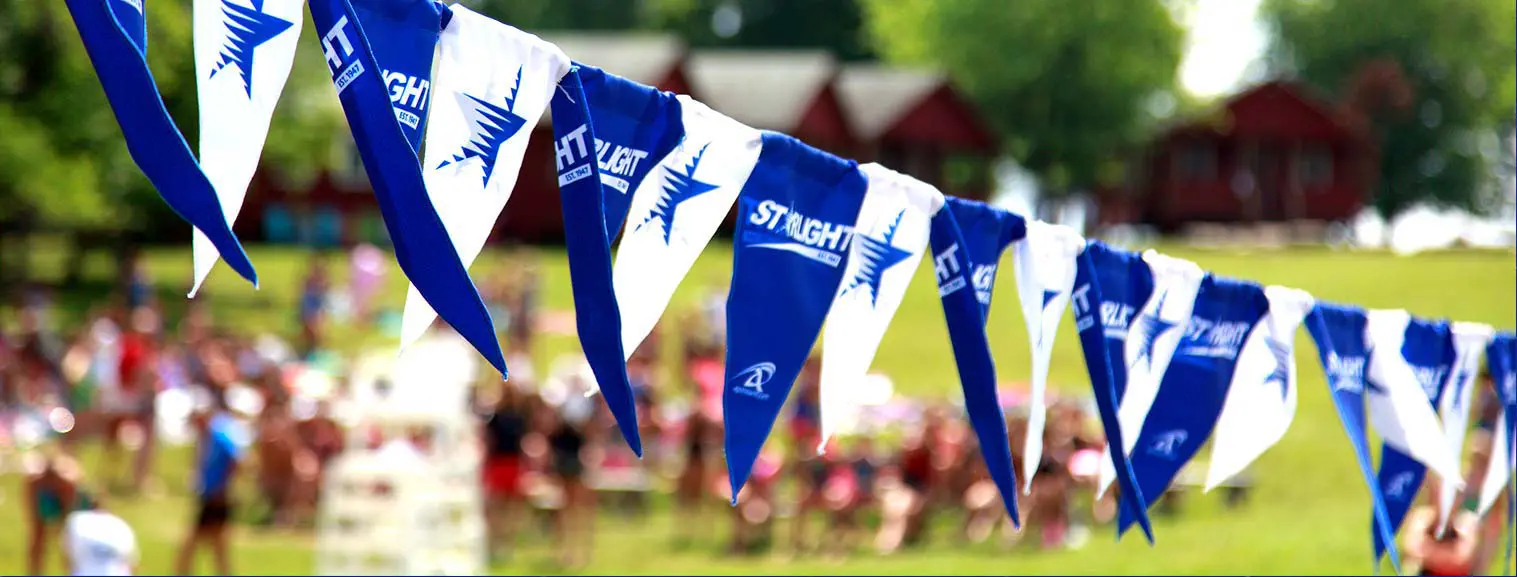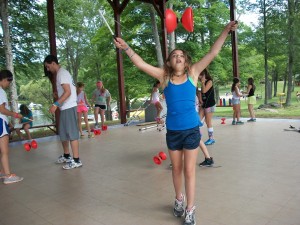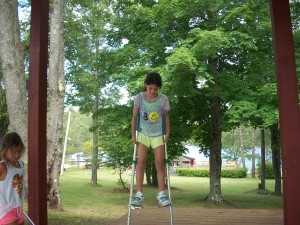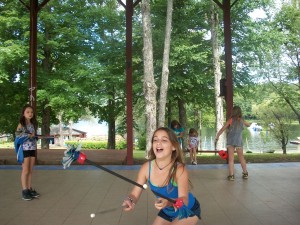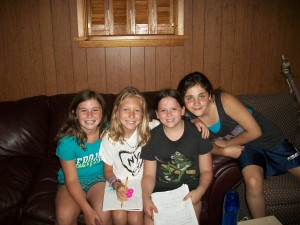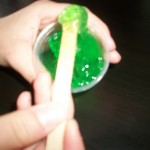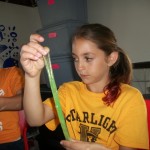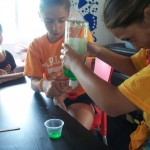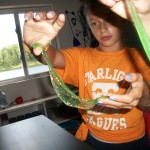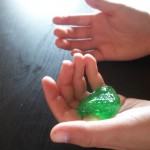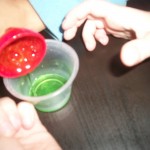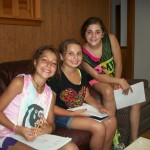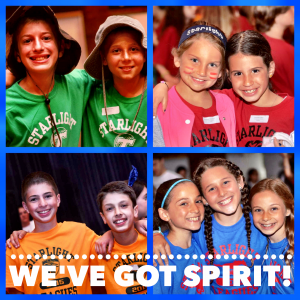 For some of the campers at Starlight, college is just around the corner. For others, college seems a distant dream of fun filled football games. And what better way to get into the spirit of pep rally life than the epic leagues breakout? With the help of the CA’s, four teams were declared, and the competition began immediately. Colors red, green, blue and yellow could be seen everywhere for colleges Temple University, Tulane, Southern Methodist University, and the University of South Florida respectively. After a cheer-off where every team gave it their all, an epic game of four corners ensued followed by other great activities. Both upper and lower camp had a blast screaming for their teams and letting their Starlight spirit be heard from miles away. The campers are eager for an amazing summer of league events filled with spirit, competition, and lots of fun.
For some of the campers at Starlight, college is just around the corner. For others, college seems a distant dream of fun filled football games. And what better way to get into the spirit of pep rally life than the epic leagues breakout? With the help of the CA’s, four teams were declared, and the competition began immediately. Colors red, green, blue and yellow could be seen everywhere for colleges Temple University, Tulane, Southern Methodist University, and the University of South Florida respectively. After a cheer-off where every team gave it their all, an epic game of four corners ensued followed by other great activities. Both upper and lower camp had a blast screaming for their teams and letting their Starlight spirit be heard from miles away. The campers are eager for an amazing summer of league events filled with spirit, competition, and lots of fun.
Posts Tagged ‘camp programs’
League Break at Camp Starlight
Thursday, July 2nd, 2015Opening Night Campfire at Camp Starlight
Thursday, July 2nd, 2015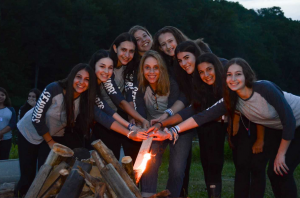 When people speak of camp, there is always talk about the camp family. Now, here at Starlight, everyone is connected through their passion for this place. Although isolated from the outside world, camp allows us to feel closer together. On the second night of camp, tradition tells us that it is time for our camp sisters. These are the older and younger siblings that are by your side for the rest of the summer. These are the people that cheer you up when you just need to laugh a little, or the people who you comfort when you know they’re feeling sad. The oldest camp sister relishes in her leadership role while the younger siblings finally feel like they are truly a part of this Starlight family. Hand in hand, all of girls side walked down to the campfire sight where the night continued. Each division stood up to lead a cheer, hearing their voices ring across the mountains and showing the girls side their Starlight spirit. Next, the upper senior girls continued a long standing tradition, expressing to the camp what being here at Starlight means to them. The campers who have been here the longest lit the campfire and smores were enjoyed by everyone. As the night came to a close, campers were asked to look up to the sky to find a star. Focusing on their star, they where then asked to make a wish for the upcoming summer. The energy in the atmosphere was magical as all of girls side stood together, kicking off the 2015 summer.
When people speak of camp, there is always talk about the camp family. Now, here at Starlight, everyone is connected through their passion for this place. Although isolated from the outside world, camp allows us to feel closer together. On the second night of camp, tradition tells us that it is time for our camp sisters. These are the older and younger siblings that are by your side for the rest of the summer. These are the people that cheer you up when you just need to laugh a little, or the people who you comfort when you know they’re feeling sad. The oldest camp sister relishes in her leadership role while the younger siblings finally feel like they are truly a part of this Starlight family. Hand in hand, all of girls side walked down to the campfire sight where the night continued. Each division stood up to lead a cheer, hearing their voices ring across the mountains and showing the girls side their Starlight spirit. Next, the upper senior girls continued a long standing tradition, expressing to the camp what being here at Starlight means to them. The campers who have been here the longest lit the campfire and smores were enjoyed by everyone. As the night came to a close, campers were asked to look up to the sky to find a star. Focusing on their star, they where then asked to make a wish for the upcoming summer. The energy in the atmosphere was magical as all of girls side stood together, kicking off the 2015 summer.
Living with Peers at Camp Starlight
Monday, March 30th, 2015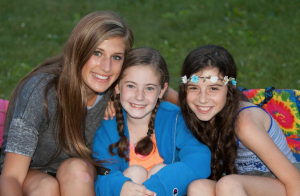 It can be emotional to think about, but one day we will have to help our babies pack up their stuff and move them into a dorm, apartment or house of their own. We have to send them off with the hope that all we did to teach them how to be productive, respectful and kind human beings will stick with them as they venture into the real world. Along with being honest and responsible, we cross our fingers that we taught them how to be a good roommate. Did we instill the importance of keeping their stuff picked up, being quiet when other people are sleeping, doing their own dishes? Did we teach them how to take care of their dirty laundry? Did we bluntly teach them to use deodorant so other people near by don’t have to? Our goal is to raise someone who is easy and fun to live with. Nobody wants to have the kid who is known for leaving his or her sweaty socks by the front door, or who never EVER takes initiative and takes out the trash. By sending them to camp, you give them the opportunity to learn what it is like to live with other people other than their immediate family, and prepares them for opportunities in the future (college, marriage, etc) where they will be sharing the same space with other people. Being a good roommate is an important quality to have, and learning how to deal with other people who aren’t the world’s best roommates is also an important life skill.
It can be emotional to think about, but one day we will have to help our babies pack up their stuff and move them into a dorm, apartment or house of their own. We have to send them off with the hope that all we did to teach them how to be productive, respectful and kind human beings will stick with them as they venture into the real world. Along with being honest and responsible, we cross our fingers that we taught them how to be a good roommate. Did we instill the importance of keeping their stuff picked up, being quiet when other people are sleeping, doing their own dishes? Did we teach them how to take care of their dirty laundry? Did we bluntly teach them to use deodorant so other people near by don’t have to? Our goal is to raise someone who is easy and fun to live with. Nobody wants to have the kid who is known for leaving his or her sweaty socks by the front door, or who never EVER takes initiative and takes out the trash. By sending them to camp, you give them the opportunity to learn what it is like to live with other people other than their immediate family, and prepares them for opportunities in the future (college, marriage, etc) where they will be sharing the same space with other people. Being a good roommate is an important quality to have, and learning how to deal with other people who aren’t the world’s best roommates is also an important life skill.
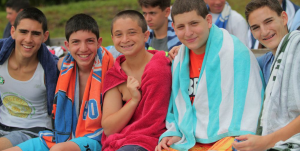 At Camp Starlight, each bunk has 8-12 campers and 2-3 counselors. Campers sleep in single beds. There is a bathroom, with two showers, two toilets, and two sinks. They have cubbies for storage and outlets to plug in clocks etc. Campers are expected to respect each other’s space and personal belongings. Everyone is responsible for keeping the cabins picked up and clean. Although uncommon, sometimes campers have a hard time adjusting to sharing a space with others, and this can cause frustration and conflict with other campers. Counselors are trained on how to deal with such conflict, and use it as a learning opportunity for all of the campers. Counselors show campers how to address someone who has invaded their space and how to communicate their feelings about how another’s actions are affecting them. Being able to effectively communicate an issue or problem you have with someone you are living with is a valuable life skill campers will learn by living with their peers.
At Camp Starlight, each bunk has 8-12 campers and 2-3 counselors. Campers sleep in single beds. There is a bathroom, with two showers, two toilets, and two sinks. They have cubbies for storage and outlets to plug in clocks etc. Campers are expected to respect each other’s space and personal belongings. Everyone is responsible for keeping the cabins picked up and clean. Although uncommon, sometimes campers have a hard time adjusting to sharing a space with others, and this can cause frustration and conflict with other campers. Counselors are trained on how to deal with such conflict, and use it as a learning opportunity for all of the campers. Counselors show campers how to address someone who has invaded their space and how to communicate their feelings about how another’s actions are affecting them. Being able to effectively communicate an issue or problem you have with someone you are living with is a valuable life skill campers will learn by living with their peers.
Part of being a good roommate is respecting the rules of quiet time, and allowing others to sleep in a space that is quiet and peaceful. Nobody likes living with someone who is up half the night talking and making noise, so it is important that campers learn this type of respect at camp. Many campers plan to move away to college, where they will be living in a dorm or apartment with other students. If they have the experience of living with others at camp, it will prepare them for the kind of roommate they want (and don’t want) to be. Having counselors in the cabins also helps to ensure all campers feel safe and respected, and that the rules are followed closely.
Kids who don’t attend sleep away camps may go straight from living in their home, with their siblings and parents, to being thrown into an environment in college where all of the sudden they have to learn a whole new set of rules, expectations and courtesy. Sending your kids to Camp Starlight gives them a big head start in the rule of sharing their space.
And this will make them one heck of a roommate when it’s time for them to be on their own.
Rain: No Problem!
Saturday, July 26th, 2014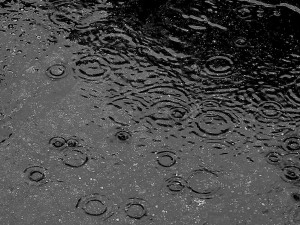 Ideally, every day at camp is sunny and warm. Unfortunately, Mother Nature doesn’t always prescribe to human ideals and, although not often, occasionally the skies are a bit more gray than blue and the weather a bit more wet than dry. Although such conditions are “ideal” they certainly don’t bring the fun and activities to a halt. Quite the contrary, those rare thunderstorms are an opportunity at camp to allow campers to enjoy special activities that are reserved for such days rather than a regular part of the daily camp program.
Ideally, every day at camp is sunny and warm. Unfortunately, Mother Nature doesn’t always prescribe to human ideals and, although not often, occasionally the skies are a bit more gray than blue and the weather a bit more wet than dry. Although such conditions are “ideal” they certainly don’t bring the fun and activities to a halt. Quite the contrary, those rare thunderstorms are an opportunity at camp to allow campers to enjoy special activities that are reserved for such days rather than a regular part of the daily camp program.
Camp Starlight has plenty of multi-purpose indoor space that can accommodate small as well as large groups of campers. Despite the gray skies, the mood is decidedly sunny indoors as campers take advantage of the extra time they have to catch up with bunk/cabin mates. Rain also slows the pace and gives campers time to reflect on their time at camp thus far. Many also use the time to write the letters home or catch up on reading.
It may be a stretch to claim that the weather outside is perfect every single day at camp, but regardless of the weather, the mood is always sunny.
A Closer Look at the Camp Starlight Circus Option
Monday, July 21st, 2014The Circus program at Camp Starlight is very popular, and for good reason. It is the only program that gives campers the opportunity to walk on stilts, juggle, do diabl0, flip devil sticks, and spin plates. Campers in the Camp Starlight Creative Writing option decided to spend some time there to see just what draws campers by the dozens each day.
The Circus program is led by Ben. He first became interested in Circus when he was in the Youth Theater, which is an amateur theater in his home country of England. Ben says that a circus person once came to his theater to demonstrate juggling and diablo, which made him very interested in all things circus. So he asked the circus person to teach him his tricks, and so the circus person taught Ben everything he knew. Ben practiced a lot, and eventually became better than his mentor.
Campers find Circus fun and different. Around the world, spaghetti string, and
throw and catch might not be familiar terms to those who aren’t familiar with the diablo. But one Junior who was interviewed by the roving reporters of the Creative Writing Option and has been to Circus five times this summer has learned all of them. For those less familiar with all things circus, a diablo is a popular circus toy comprised of two large cylinders attached to both ends of a metal center piece that are balanced and juggled on a piece of string controlled by two sticks.
For campers who are looking for an activity they can’t try at home, Circus is the perfect choice. Every camper interviewed at Circus told us that they learned everything they know about Circus at Camp Starlight. Favorite camper activities at Circus include, devil sticks (aka Chinese juggling sticks), stilts, and the balance board known as a tiabolow. Many Camper Starlight campers build their skills at Circus over multiple summers. One particular enthusiast of the stilts said she has been learning and practicing the art of stilt walking for more than a year.
Circus was even offered as a Starcamp at Camp Starlight this year. Special
guests from Ringling Brothers, Barnum and Bailey Circus taught campers the art of Circus comedy that included pies in the face, water
throwing, and gags, which are funny skits that many circus clowns perform in between acts during circus shows. Campers also learned new circus skills, such as getting up on stilts without the aid of a wall as well as new juggling and spinning tricks with the circus tools available at Camp Starlight. The Ringling Brothers crew shared that in addition to camp clinics, they also perform for patients at children’s hospitals.
Campers agree that the circus is fun to watch but even more fun to actually do. It is no wonder campers rate the Camp Starlight Circus program a 10!
Options, Options, and More Options
Tuesday, July 15th, 2014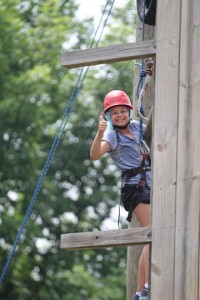 Parents of Camp Starlight campers know that the Camp Starlight program is a unique combination of structure and choice. Few probably realize, however, just how many activities there are from which to choose. In addition to popular sports and other activities that are part of the regular program, campers choose from dozens of arts, hobby, and science related programs. Campers can explore their creative sides through writing, photography, arts & crafts, and woodworking options. Those campers with a passion for science can engage in fun science experiments, build rockets and robots, or construct an object using the brand new 3D printer in the Maker’s Space area. Performing arts loving campers can develop skills in sports broadcasting and radio broadcasting, dance, theater improv, television and movie production, circus, and even magic. Aside from our popular swimming and boating programs, water lovers can also have the opportunity to go paddleboarding, play water polo, or even choreograph their own synchronized swimming routines. Of course, no
Parents of Camp Starlight campers know that the Camp Starlight program is a unique combination of structure and choice. Few probably realize, however, just how many activities there are from which to choose. In addition to popular sports and other activities that are part of the regular program, campers choose from dozens of arts, hobby, and science related programs. Campers can explore their creative sides through writing, photography, arts & crafts, and woodworking options. Those campers with a passion for science can engage in fun science experiments, build rockets and robots, or construct an object using the brand new 3D printer in the Maker’s Space area. Performing arts loving campers can develop skills in sports broadcasting and radio broadcasting, dance, theater improv, television and movie production, circus, and even magic. Aside from our popular swimming and boating programs, water lovers can also have the opportunity to go paddleboarding, play water polo, or even choreograph their own synchronized swimming routines. Of course, no 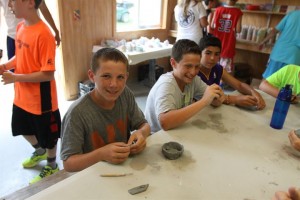 one could—or does—forget about all of options available as part of the comprehensive Outdoor Adventure program here at Camp Starlight. High and low ropes, outdoor living skills, mountain biking, fishing, hiking, climbing and ziplining are just a handful of the choices available to campers who choose the Outdoor Adventure option. Add in the more unique games that are featured as part of the Super Sixth option and the list of possibilities seems nearly limitless. So many options…so little time. In fact, the unique combination of activities that campers choose for themselves makes each summer an exclusive, once in a lifetime, experience!
one could—or does—forget about all of options available as part of the comprehensive Outdoor Adventure program here at Camp Starlight. High and low ropes, outdoor living skills, mountain biking, fishing, hiking, climbing and ziplining are just a handful of the choices available to campers who choose the Outdoor Adventure option. Add in the more unique games that are featured as part of the Super Sixth option and the list of possibilities seems nearly limitless. So many options…so little time. In fact, the unique combination of activities that campers choose for themselves makes each summer an exclusive, once in a lifetime, experience!
Messy Fun in Maker’s Space
Wednesday, July 9th, 2014Maker’s Space is a new area at camp in which campers can choose from three focus activities: eco-science, robotix and 3-D printing, and rocketry. Today, Lower Inter Girls Sammy B., Brooke H., and Zoe S. used their creative writing option period to learn a little bit more about what the eco-science component of Maker’s Space is all about.
Maker’s Space is taught by Kieran, who is studying marine biology at Bangor University in North Wales. When creative writing visited, a group of Lower Camp Girls was busy making slime. Kieran explained the slime is really easy to make. All you need is 2 tablespoons of slime goo and a half tablespoon of cross linker, both of which are available as a kit from Steve Spangler science. He said that slime is a lot of fun to make because you can do all sorts of things with it, including bounce it when it is in ball form.
The girls from creative writing learned that campers like maker’s space option because of the lizard and bearded dragon, because it is fun and different, and (what better reason for an activity area called Maker’s Space?) to make stuff. The girls were really excited to be making slime and said that it felt slimy, gooey, nice, and sticky. Campers are also looking forward to having more fun with science in other areas of Maker’s Space as well.
- The Roving Reports of Creative Writing Option
Not Your Mom and Dad’s Arts and Crafts
Sunday, April 20th, 2014 Summer camp arts and crafts programs often conjure images of beading lanyards and tie dying. Indeed, crafts are still a large part of camp, but art is becoming equally as important. That is to say that camps are investing more in open ended mediums that encourage campers to use their creativity to create works of their volition as opposed to pre-determined projects of summer camps past.
Summer camp arts and crafts programs often conjure images of beading lanyards and tie dying. Indeed, crafts are still a large part of camp, but art is becoming equally as important. That is to say that camps are investing more in open ended mediums that encourage campers to use their creativity to create works of their volition as opposed to pre-determined projects of summer camps past.
The difference between art and crafts may not be immediately clear to those who envision a room at summer camp that houses a seemingly unlimited supply of paintbrushes, glitter, paint, markers, glue, construction paper, and beads. There is a marked difference, however. A recent article featured in Early Childhood News, M.A. and creative arts instructor Anna Reyer outlines the distinctions between art and crafts. Primarily art is open ended creations that evolve from a variety of supplies and minimal guidance. Crafts are pre-scripted projects assembled using specific supplies and guidelines with a finished product that is the same or similar for everyone. There is something to be said for both the “arts” and the “crafts” of arts and crafts.
Crafts are fun, and many a camper sings the praises of the relaxation and satisfaction derived from a few minutes of down time in which they are given a set of materials and a set of instructions and are left to their own devices. It is an opportunity to be social and engage in casual conversation with other campers and counselors. There is also a sense of satisfaction with the end product, a three-dimensional completed object that the camper created from a group of raw materials.
Then there is art, the benefits of which are becoming increasingly obvious to camp owners and directors. Art projects  provide campers with a period of time during the day in which very little, if anything, has been planned for them. It is their time to create as they choose. Whether it is painting or creating a piece of jewelry, it is a sanctioned part of the day that is limited only by their imaginations. Camp in general is a creative space. Through art, it is also an imaginative space. It’s a space in which children are free to unwind and mentally process their feelings. Art is the perfect opportunity for campers to recharge and turn around a day that has been less than perfect. In that regard, similar things could be said about camp music, theater, and dance programs.
provide campers with a period of time during the day in which very little, if anything, has been planned for them. It is their time to create as they choose. Whether it is painting or creating a piece of jewelry, it is a sanctioned part of the day that is limited only by their imaginations. Camp in general is a creative space. Through art, it is also an imaginative space. It’s a space in which children are free to unwind and mentally process their feelings. Art is the perfect opportunity for campers to recharge and turn around a day that has been less than perfect. In that regard, similar things could be said about camp music, theater, and dance programs.
With the importance placed on creativity, fun, and happiness at summer camp, it is natural that summer camps invest big in arts and crafts programs. A memorable summer is more than just the glory of scoring a winning goal or swimming in the lake. Those times in which campers are left to their creative devices and are free to interact or not interact as they please provide crucial balance to the rest of the summer camp experience.
Yes, You Can
Tuesday, March 25th, 2014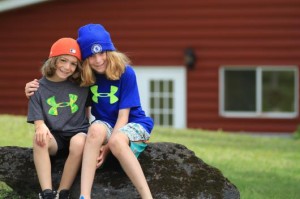 “No” is a word that children hear a lot. No talking in the classroom. No running in the hallways. No playing ball in the house. No to anything that gets clothes dirty. No. No. No. With this in mind, it’s no wonder that “yes” is one of the many reasons that children so eagerly anticipate camp each summer. Of course safety is always a factor, and children also have parameters at camp for that reason. However, those parameters extend much further at summer camp than they do at home and school. At summer camp, campers are encouraged to climb walls, zip down ropes, run, get dirty and play ball. Even when they express doubt in themselves, they are encouraged with, “Yes, you can.” There is no pressure to be the best at something or to even be good at it, simply to try it. With such encouragement, many campers venture into previously unexplored territory and discover that they can, in fact, do things they previously thought they couldn’t.
“No” is a word that children hear a lot. No talking in the classroom. No running in the hallways. No playing ball in the house. No to anything that gets clothes dirty. No. No. No. With this in mind, it’s no wonder that “yes” is one of the many reasons that children so eagerly anticipate camp each summer. Of course safety is always a factor, and children also have parameters at camp for that reason. However, those parameters extend much further at summer camp than they do at home and school. At summer camp, campers are encouraged to climb walls, zip down ropes, run, get dirty and play ball. Even when they express doubt in themselves, they are encouraged with, “Yes, you can.” There is no pressure to be the best at something or to even be good at it, simply to try it. With such encouragement, many campers venture into previously unexplored territory and discover that they can, in fact, do things they previously thought they couldn’t.
The benefits of such encouragement extend beyond the development of courage to try new things. Children become more open to 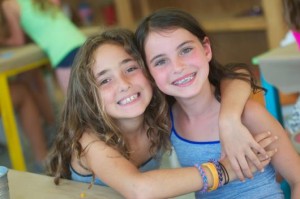 possibilities. They develop the skills to venture out of their comfort zone and examine situations from different angles. A refined sense of creativity helps them attack tasks that previously seemed difficult or even impossible. They learn to comprehend the importance of trying, particularly when the time and place is right. With such perspective, “no” and “yes” become words less associated with ability and more associated with restraint. If they’re talking in the classroom, they can’t understand what the teacher is saying. School is not an environment that makes running in the hallways safe. Things tend to break when they play ball in the house. The clothes they wear when they’re not at camp are just a little nicer than the ones they tend to wear at camp. In contrast, camp is a safe environment for them to talk, laugh, run, play, climb and get messy in ways that are productive. In short, it’s an environment with less restraint in mind. Once children are able to understand the symbiotic relationship between “yes” and “no,” they are better able to accept “no” for what it actually means: It’s not in your best interest.
possibilities. They develop the skills to venture out of their comfort zone and examine situations from different angles. A refined sense of creativity helps them attack tasks that previously seemed difficult or even impossible. They learn to comprehend the importance of trying, particularly when the time and place is right. With such perspective, “no” and “yes” become words less associated with ability and more associated with restraint. If they’re talking in the classroom, they can’t understand what the teacher is saying. School is not an environment that makes running in the hallways safe. Things tend to break when they play ball in the house. The clothes they wear when they’re not at camp are just a little nicer than the ones they tend to wear at camp. In contrast, camp is a safe environment for them to talk, laugh, run, play, climb and get messy in ways that are productive. In short, it’s an environment with less restraint in mind. Once children are able to understand the symbiotic relationship between “yes” and “no,” they are better able to accept “no” for what it actually means: It’s not in your best interest.
Camp Pets
Saturday, March 8th, 2014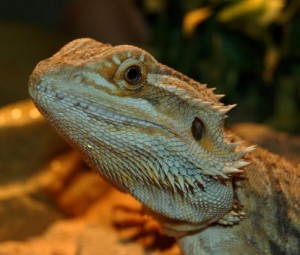 Experts unanimously agree that there are benefits to pet ownership for children. In addition to teaching them responsibility, pets also entertain children, keep them active, alleviate stress and teach them about life. For some families, however, busy lifestyles make pet ownership impractical and even unrealistic. Enter another little known benefit of summer camp: summer pets. Many camp nature, exploration, and eco-science programs include an animal or two. Because of allergies, camps tend to shy away from common household pets such as cats and dogs. Rather, animals with naturally reserved demeanors that are easy to handle like reptiles, rabbits, turtles and guinea pigs are preferable when it comes to camp pets. As a result, even campers who have pets at home get the opportunity to handle, care for and observe – to their comfort level – animals they may not frequently encounter. Those campers who do not have pets at home get to experience the joy of pet ownership and all of the benefits of it while those campers who do have pets at home tend to miss them less when their camp has animals. Camp pets sometimes double as mascots and campers come to view them as part of their camp. Best of all, everyone at summer camp, regardless of whether they have pets at home or not, has the opportunity to have a pet for at least a few weeks each year.
Experts unanimously agree that there are benefits to pet ownership for children. In addition to teaching them responsibility, pets also entertain children, keep them active, alleviate stress and teach them about life. For some families, however, busy lifestyles make pet ownership impractical and even unrealistic. Enter another little known benefit of summer camp: summer pets. Many camp nature, exploration, and eco-science programs include an animal or two. Because of allergies, camps tend to shy away from common household pets such as cats and dogs. Rather, animals with naturally reserved demeanors that are easy to handle like reptiles, rabbits, turtles and guinea pigs are preferable when it comes to camp pets. As a result, even campers who have pets at home get the opportunity to handle, care for and observe – to their comfort level – animals they may not frequently encounter. Those campers who do not have pets at home get to experience the joy of pet ownership and all of the benefits of it while those campers who do have pets at home tend to miss them less when their camp has animals. Camp pets sometimes double as mascots and campers come to view them as part of their camp. Best of all, everyone at summer camp, regardless of whether they have pets at home or not, has the opportunity to have a pet for at least a few weeks each year.



